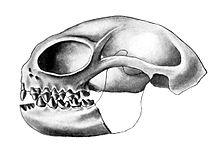Omomyidae
| Omomyidae | |
|---|---|

| |
| The skull of Anaptomorphus | |
| Scientific classification | |
| Domain: | Eukaryota |
| Kingdom: | Animalia |
| Phylum: | Chordata |
| Class: | Mammalia |
| Order: | Primates |
| Suborder: | Haplorhini |
| Clade: | † Omomyiformes
|
| Superfamily: | †Omomyoidea |
| Family: | †Omomyidae |
| Subgroups | |
| |
| Synonyms | |
Omomyidae is a group of early
Characteristics

Features that characterize many omomyids include large orbits (eye sockets), shortened
Like
Omomyid systematics and evolutionary relationships are controversial. Authors have suggested that omomyids are either:
- stem
- stem tarsiiformes [i.e., basal offshoots of the tarsier lineage].[6]
- stem primates more closely related to adapids than to living primate taxa.
Recent research suggests the Omomyiformes are stem haplorhines, making them likely a paraphyletic grouping.[7]
Attempts to link omomyids to living groups have been complicated by their primitive (
- significant reduction of the canal for the stapedial branch of the internal carotid artery.
- route of the canal to house the promontory branch of the internal carotid artery through the auditory bulla of the temporal bone, i.e. "perbullar" (rather than across the promontory of tympanic cavity, "transpromontorial") .
- contact between the alisphenoid and zygomaticbones.
- presence of an anterior accessory cavity confluent with the tympanic cavity.
Omomyids further demonstrate a gap between the upper central incisors, which presumably indicates the presence of a
Among primates, omomyids have a uniquely derived characteristic. This is the presence of an aphaneric (not visible or readily distinguishable, due to its position), or "intrabullar" (within the bullae), ectotympanic bone, connected to the lateral wall of the auditory bulla by an unbroken annular bridge.
Classification
This section needs additional citations for verification. (December 2023) |
- Family Omomyidae
- Altanius
- Kohatius
- Subfamily Anaptomorphinae
- Tribe Trogolemurini
- Subfamily Microchoerinae
- Subfamily Omomyinae
- Brontomomys[9]
- Diablomomys
- Ekwiiyemakius[9]
- Gunnelltarsius[9]
- Huerfanius
- Mytonius
- Palaeacodon
- Tribe Rooneyini
- Tribe Steiniini
- Tribe Uintaniini
- Tribe Hemiacodontini
- Tribe Omomyini
- Tribe Macrotarsiini
- Tribe Washakiini
- Tribe Utahiini
References
- ISBN 978-0-8160-1194-0.)
{{cite book}}: CS1 maint: multiple names: authors list (link - S2CID 54167483.
- ^ a b Rachel H. Dunn. "Additional postcranial remains of omomyid primates from the Uinta Formation, Utah and implications for the locomotor behavior of large-bodied omomyids". Journal of Human Evolution Volume 58, Issue 5, May 2010, pp. 406-417
- ^ "Early Primates Groomed with Claws".
- S2CID 220087294.
- ^ Szalay, Frederick (1976). "Systematics of the Omomyidae (Tarsiiformes, Primates): Taxonomy, phylogeny, and adaptations". Bulletin of the American Museum of Natural History. 156 (3): 157–450.
- PMID 29447758.
- ^ doi:10.26879/1246.
- ^ a b c Amy L. Atwater; E. Christopher Kirk (2018). "New middle Eocene omomyines (Primates, Haplorhini) from San Diego County, California". Journal of Human Evolution. in press. doi:10.1016/j.jhevol.2018.04.010.
